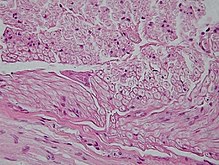nerve
A nerve ( Latin nervus , abbreviation N. , plural nervi , abbreviation Nn .; From ancient Greek νεῦρον neúron , German 'thread' , 'sinew' or 'cord', 'string', 'nerve') is parallel running nerve fibers (cell processes: axons and dendrites ) that lie in a connective tissue sheath. Nerves belong to the peripheral nervous system and serve to exchange information in the animal organism .
construction
The individual axons of a nerve (colloquially also "a nerve") are enclosed by a connective tissue covering called the endoneurium . Several axons are grouped into nerve fiber bundles, so-called fascicles , which in turn are covered by connective tissue ( perineurium ). The connective tissue covering the entire nerve is called the epineurium .
In the case of non-peripheral nerves, such as the optic nerve , the outer covering is formed from the meninges . Here the dura mater forms the epineurium ; The arachnoid and pia as well as the subarachnoid space also surround the optic nerve and form the peri- and endoneurium .
Subdivision
According to the origin of the nerves, vertebrates distinguish between spinal nerves , which leave the central nervous system (CNS) in the region of the spinal cord , and cranial nerves , which arise from the brain . In the area of the limbs origins of the spinal nerve plexuses (form brachial plexus , lumbosacral plexus ), in which proportions of various spinal nerves and mix Plexusnerven form.
Afferents (towards the central nervous system) and efferents (from the CNS to the periphery) are distinguished according to the direction of the conduction of excitation . The afferents conduct sensitive or sensory information, so they are used to perceive internal and external stimuli. The efferents conduct motor or secretory impulses. According to the target area, the afferent and efferent nerves are further divided into somatic (nerves of the body wall; from ancient Greek σῶμα sṓma , German ` ` body '' ) and visceral (nerves of the intestines ; from Latin visceralis , ` ` concerning the intestines '' ). Most nerves are mixed nerves , that is, contain both afferent and efferent processes.
On the way to their target area ( innervation area), the nerves keep branching out. The smaller nerve branches are called Rami (Sg. Ramus ).
See also
- Nervous disease
- Nerve cell
- Nervous system
- ganglion
- Dermatome (anatomy)
- Neurapraxia
- Neurotomy
- Sensitivity (neuroscience)
literature
- Friedrich Solmsen : Greek philosophy and the discovery of the nerves. (Original title: Greek philosophy and the discovery of the nerves. In: Museum Helveticum 18, 1861, pp. 150–197; also in: Kleine Schriften. , I – III, Hildesheim 1968–1982, Volume I (1968), p. 536–582) Translated from English by Dorothea Flashar. In: Hellmut Flashar (ed.): Ancient medicine. Darmstadt 1971 (= ways of research , 221), pp. 202-279.


